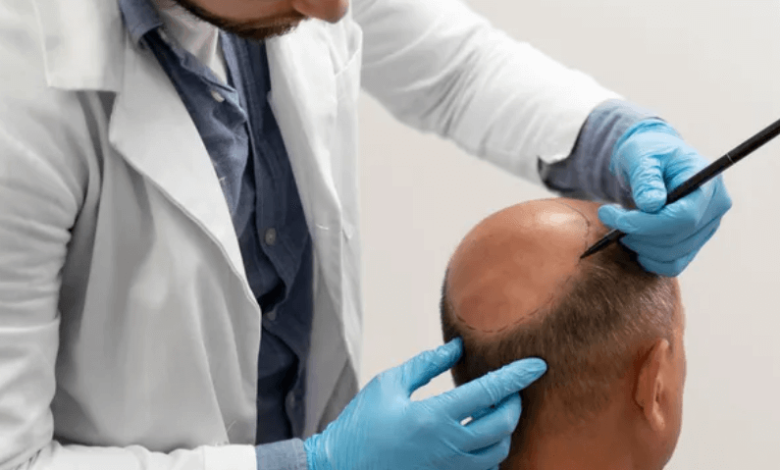FUE, DHI & Robotic: New Hair Transplant Techniques That Make Results Look Amazingly Natural

For many people, the thought of getting a hair transplant brings hope but there’s often one lingering fear: Will it look obvious? Thankfully, the days of an unnatural, pluggy hairline are long gone. Modern techniques like FUE, DHI, and robotic-assisted procedures have transformed hair restoration into an art form that achieves results so natural, even your barber might not notice.
If you’re already exploring ways to improve hair health, you might also want to learn how to choose the best scalp serum for your hair type because healthy roots make every treatment more effective.
At some clinics, advanced technology and the surgeon’s eye for detail work together to deliver the best hair transplant experience with results that truly look and feel like your own hair.
The Journey from Obvious Plugs to Natural Follicular Units
Hair transplantation has come a long way since its early days in the 1950s. Back then, the only option involved transplanting large plugs of hair-bearing skin, which left patients with round, artificial-looking patches. Over the decades, the industry evolved to focus on follicular units, the naturally occurring groups of one to four hairs that grow together. This breakthrough set the stage for FUE, DHI, and robotics to push the limits of what’s possible.
Why FUE Is the Modern Standard
Follicular Unit Extraction, or FUE, is now one of the most popular hair restoration methods worldwide. Unlike the traditional strip method, FUE involves extracting each follicular unit individually from the donor area, usually at the back of your head. Each unit is then carefully implanted in the areas where you need regrowth.
One reason FUE stands out is its ability to avoid large, visible scars. Instead, the surgeon uses tiny, precise punches that heal quickly, leaving minimal trace even with shorter hairstyles. Patients also appreciate that the recovery period is relatively quick and comfortable compared to older methods.
Another key benefit of FUE is that surgeons can angle each hair to follow your natural growth direction. This detail makes all the difference in blending your new hairline seamlessly with your existing hair. At Centers like Redefine, surgeons take time to study your facial features and hair texture to create a custom hairline design that suits you for years to come.
See also: Hajj and Umrah Health Precautions Ensure For Safety
How DHI Takes Precision Even Further
Direct Hair Implantation, or DHI, builds upon the FUE method and adds an extra level of finesse. With DHI, surgeons use a tool called the Choi Implanter Pen to extract and implant hairs in one continuous process. This reduces the time each follicle stays outside the body, which helps improve survival rates and encourages strong regrowth.
DHI doesn’t require the surgeon to create recipient incisions ahead of time. Instead, each follicle is inserted directly into the scalp at the right angle and depth, which allows for higher graft density and more refined hairline work. Many patients appreciate that DHI sometimes requires only partial shaving of the donor area, making it less disruptive to your daily life.
People who want to restore delicate areas like the hairline or eyebrows often choose DHI for its precision. The method’s focus on detailed placement means the final result looks thick, healthy, and indistinguishable from your original hair.
Robotic Hair Transplants: Merging AI with Surgical Artistry
The rise of robotic hair transplant systems, like the ARTAS Robot, represents another leap forward in hair restoration. These systems use artificial intelligence and advanced imaging to help surgeons harvest donor hairs with extreme accuracy.
Robotic systems scan your scalp in real time, analyzing hair angles, density, and growth patterns. They then extract the healthiest follicles while minimizing damage to the surrounding tissue. This consistency reduces the chance of over-harvesting and helps keep the donor area looking natural.
It’s important to understand that robotics don’t replace your surgeon. Instead, they enhance the surgeon’s work by handling repetitive, precise tasks while the human touch still guides the artistry of hairline design and graft placement. The blend of machine precision and a skilled surgeon’s experience makes robotic procedures an exciting option for those who want the most advanced technology available.
Why Combining Techniques Matters
One size rarely fits all when it comes to hair restoration. Experienced clinics like Redefine often combine methods to achieve the most natural result. For example, a patient might undergo FUE for most of the scalp while using DHI for hairline detailing. Robotic extraction might be used to speed up the harvest phase, while the surgeon carefully places each graft by hand for a softer, more realistic finish.
Supportive treatments like PRP therapy can also be added to stimulate healing and improve the overall outcome. Platelet-Rich Plasma, derived from your own blood, can boost follicle strength and encourage healthy new growth. This kind of multi-step approach means the final result not only looks natural but stays strong for years to come.
What Makes Modern Transplants Look So Real
One of the biggest changes in hair transplantation is the shift from focusing solely on coverage to paying attention to design, density, and the natural direction of hair growth. Today’s skilled surgeons take time to map out a hairline that matches your age, facial features, and personal style. This careful planning avoids the telltale straight, rigid lines that once gave away old transplants.
Smaller grafts mean each follicle blends seamlessly with the next. By matching the angle and curl of your existing hair, the new growth appears as if it has always been there. This is especially true when working around the hairline or temples, where hair naturally grows in irregular, soft patterns.
How Long Will Your Results Last?
A common question people ask is whether one hair transplant is enough for life. The good news is that transplanted hair is usually permanent because the donor hairs come from areas genetically resistant to balding. However, untreated areas of your scalp can still thin with age, which means some people may choose touch-up procedures later on.
Maintaining your results means following your surgeon’s aftercare instructions carefully. Regular check-ups and supportive treatments like PRP or recommended medications can help protect your investment. Using the right scalp care products and paying attention to overall hair health are also smart ways to make sure your new hair stays strong.
A Worthwhile Investment in Confidence
Modern hair restoration is about so much more than adding strands to your scalp. For many people, it’s a chance to feel like themselves again to look in the mirror and see the hair they remember, styled the way they like. Choosing the hair transplant method is an investment in your appearance, your confidence, and even your professional life.
Clinics are changing the game by combining trusted techniques like FUE and DHI with the latest technology, all guided by a surgeon’s experience and eye for detail. From your first consultation to your final result, the goal is to help you feel comfortable, confident, and proud of your hair.
Conclusion
From the artistry of FUE and the added precision of DHI to the exciting possibilities of robotic systems, modern hair transplant techniques continue to evolve. If you’ve ever worried about your hair loss looking obvious or fake, it’s time to let go of those fears. With today’s advances, your hair can look so natural that no one will know you had a procedure unless you decide to tell them.
Ready to redefine your confidence? Start by consulting a trusted clinic, where your journey toward natural-looking, fuller hair is in the hands of experts who combine the best of technology and artistry. The best hair transplant results aren’t just about hair, they’re about helping you feel like the best version of yourself.




